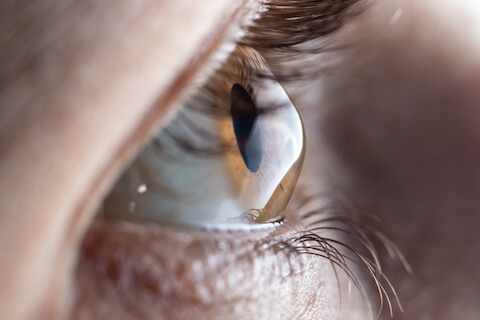
If your cornea appears misshapen, it may be because of a condition called keratoconus. The eye physicians at Shoreline Vision are experts at treating keratoconus and other eye conditions.
What is Keratoconus?
Keratoconus is a progressive eye condition that often starts when people are in their late teens to early twenties. It occurs when the cornea gradually bulges out and starts resembling a cone shape.
The cornea is the clear, dome-shaped front surface of the eye. When the cornea becomes more cone-shaped, it causes blurred vision. This may also result in light sensitivity and glare.
It may take as long as ten years or more for the condition to progress. Keratoconus will usually affect both eyes, but there is often one eye that it affects more than the other.
Are There Symptoms with Keratoconus?
If you have keratoconus, you may not realize you have it at first. Common symptoms associated with the eye condition include the following:
- Experiencing a sudden worsening of your vision
- Vision becoming more cloudy
- Needing more frequent changes in eyeglass prescriptions
- Becoming more and more sensitive to bright light and glare
- Finding it harder to drive at night
- Blurred or distorted vision
If it seems like your vision is getting worse, you may want to see your eye doctor. Even if you do not have keratoconus, they may want to rule out other eye conditions. If you do have keratoconus, they will want to start treatment sooner than later.
Treating Keratoconus: Eyeglasses and Contact Lenses
If your eye doctor diagnoses you with keratoconus, the next step is to begin treatment. Treating keratoconus depends on the severity of the condition and how quickly it has already progressed.
When treating this eye condition, most eye doctors take two approaches. The first is to slow down the progression of the disease. The second approach is to improve your vision.
For patients with early keratoconus, vision correction may stick to eyeglasses or soft contact lenses. These methods of vision correction can help with blurry or distorted vision being experienced. As their keratoconus continues progressing, these patients will have to frequently change their prescriptions for eyeglasses or contact lenses, as the shape of their corneas will only continue changing.
In more advanced stages of keratoconus, patients may move on to hard contact lenses, which provide clear vision and can be made to fit the corneas. Another kind of lens a patient with advanced keratoconus may try are scleral lenses.
Scleral lenses do not rest on the cornea like a traditional contact lens but on the white part of the eye (the sclera) and move over the cornea without touching it. This lens can be helpful when keratoconus causes the cornea to become quite irregular in shape.
Corneal Collagen Cross-Linking
Another method of treating keratoconus is with a treatment option called corneal cross-linking. With corneal cross-linking, the cornea is saturated with riboflavin eye drops and then treated with ultraviolet light.
This is what causes the “cross-linking” of the cornea. By cross-linking the cornea, it stiffens it and prevents any further shape changes. If performed before keratoconus has become advanced, it can slow progression and prevent further vision loss.
Corneal cross-linking cannot reverse any changes to the cornea that have already occurred. It can only keep them from getting worse or progressing further.
Surgical Options for Keratoconus
For patients with corneal scarring, poor vision even when using the strongest prescription eyeglasses, an inability to wear any kind of contact lenses, corneal scarring, or extreme thinning of the cornea, they may need to have surgery. The most common surgical procedures include a cornea transplant (keratoplasty), penetrating keratoplasty, and Descemet’s Stripping Endothelial Keratoplasty (DSEK).
Cornea Transplant
If you have suffered from corneal scarring or extreme thinning of the cornea, a cornea transplant is likely necessary. If you need a full-cornea transplant, you will have a penetrating keratoplasty. During this procedure, a full thickness portion of the central part of the cornea is removed. After removing this part of the cornea, it is replaced with donor tissue.
Descemet’s Stripping Endothelial Keratoplasty
DSEK is the latest and most advanced procedure available in cornea transplantation. Dr. Lee Webster at Shoreline Vision performs DSEK on many patients, rather than the traditional full thickness cornea transplant. DSEK replaces only the abnormal layer of the cornea, leaving the rest of the healthy cornea untouched.
Even after a surgical corneal transplant or other procedure, patients may experience complications like poor vision, infection, and astigmatism. With astigmatism, this is usually manageable by having the patient wear hard contact lenses again. This is easier for patients and more comfortable after a surgical procedure to treat keratoconus.
If you have keratoconus, it is important to treat it and have a plan in place. Shoreline Vision has six convenient locations for our patients to schedule appointments, including in Fremont, Muskegon, North Muskegon, Norton Shores, Grand Haven, and Spring Lake, MI. Schedule an appointment with one of our experienced ophthalmologists today.






